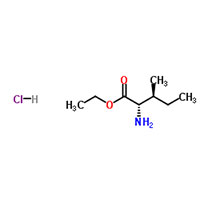L-Isoleucine Ethyl Ester Hydrochloride
Nanjing Finechem Holdings Co., LTD
Synonyms
Ethyl L-isoleucinate hydrochloride
L-Isoleucine, ethyl ester, hydrochloride (1:1)
Isoleucine ethyl ester hydrochloride
Ethyl 2-amino-3-methylvalerate hydrochloride
D-Isoleucine Ethyl Ester HCl
Ethyl L-isoleucinate hydrochloride (1:1)
2Y1&YZVO2 &&S or L Form HCl
H-Ile-OEt.HCl
Product Description
Introduction:
L-Isoleucine Ethyl Ester Hydrochloride is a chemical compound derived from L-isoleucine, an essential
amino acid with important roles in protein synthesis and metabolism. This product is widely utilized in
the pharmaceutical, research, and chemical industries due to its unique properties and various
applications.
Raw Materials:
L-Isoleucine Ethyl Ester Hydrochloride is synthesized using high-quality raw materials, including
L-isoleucine and ethanol. L-isoleucine, obtained through appropriate chemical reactions or enzymatic
processes, serves as the starting material for the synthesis. Ethanol, a commonly used solvent and
reagent in organic synthesis, is used for esterification to produce L-Isoleucine Ethyl Ester.
Production Process:
The production of L-Isoleucine Ethyl Ester Hydrochloride involves carefully controlled steps to ensure
consistent product quality. L-isoleucine is first obtained from a reliable source and then reacted with
ethanol under specific conditions. The esterification reaction is closely monitored, and the resulting
L-Isoleucine Ethyl Ester is converted into the hydrochloride salt form for improved stability and
solubility. Purification techniques such as crystallization and filtration are employed to obtain a pure
and crystalline form of L-Isoleucine Ethyl Ester Hydrochloride.
Market Trends:
L-Isoleucine Ethyl Ester Hydrochloride enjoys significant demand in the pharmaceutical and research
industries due to its potential applications. In the pharmaceutical sector, it serves as a valuable
intermediate for the synthesis of various drug molecules and pharmaceutical intermediates. It can also
be used in peptide synthesis and drug delivery systems. The market demand for L-Isoleucine Ethyl Ester
Hydrochloride is driven by the continuous need for innovative compounds in drug discovery and
research.
Amino Acid Status:
L-Isoleucine is an essential amino acid that plays important roles in protein synthesis, muscle growth,
and energy metabolism. By esterifying L-isoleucine with ethanol, L-Isoleucine Ethyl Ester Hydrochloride
offers enhanced stability and solubility, making it suitable for various applications in the
pharmaceutical and chemical industries.
Conclusion:
L-Isoleucine Ethyl Ester Hydrochloride is a valuable compound with diverse applications in the
pharmaceutical, research, and chemical industries. Its synthesis from high-quality raw materials and
stringent production processes ensure consistent product quality. The market demand for L-Isoleucine
Ethyl Ester Hydrochloride is expected to continue growing due to its unique properties and potential
applications in drug discovery, pharmaceutical synthesis, and research endeavors. With its versatile
applications and potential contributions to pharmaceutical development and scientific advancements,
L-Isoleucine Ethyl Ester Hydrochloride provides a valuable option for formulation and application in
different industries, supporting drug synthesis, peptide chemistry, and research endeavors.





